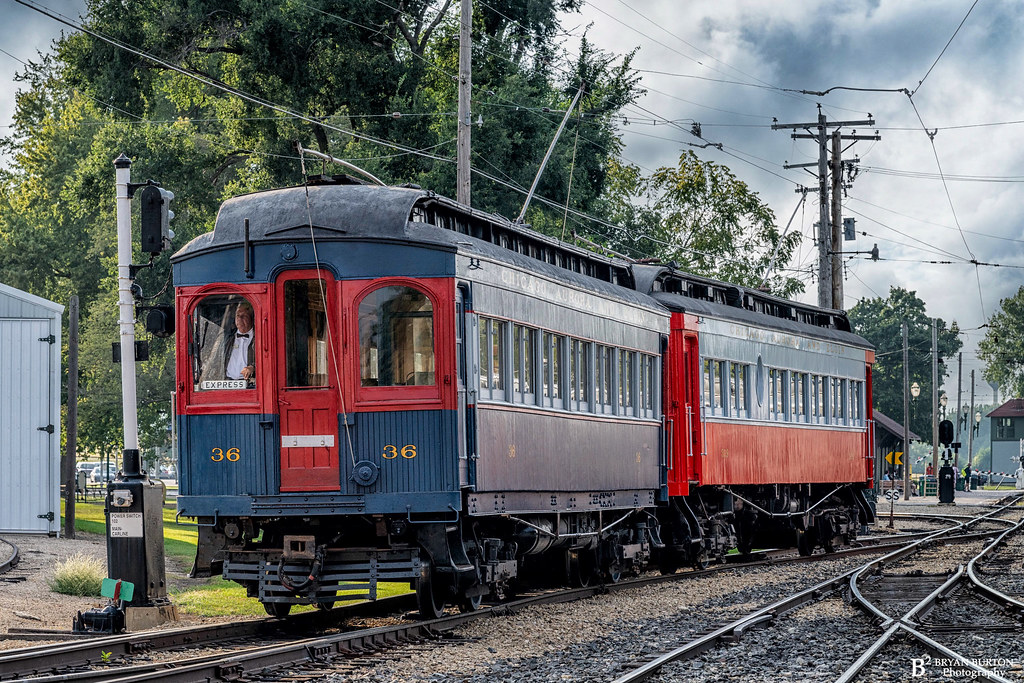#Stephenson’s railway
Text
Winter warmer train ride at Stephenson’s Railway
We enjoyed a winter warmer trail ride at Stephenson’s Railway so thought I’d share an honest review.
I booked the tickets to give us something to do during twixmas and get us out of the house.
We made a day of it in North Tyneside enjoying a play date with friends at Acorn and Oak at Newcastle Quays before heading to Stephenson’s Railway for the 3pm winter warmer train ride.
About Stephenson’s…

View On WordPress
0 notes
Text

On this day the Britannia Bridge to Anglesey, Wales opened in 1850
#Britannia Bridge#Wales#Isle of Anglesey#UK#5 March 1850#Bangor#Menai Strait#railway bridge#Robert Stephenson
23 notes
·
View notes
Photo

Nochmal der ADLER auf Tour in Koblenz
Once again the ADLER on tour in Koblenz
#dampflokblog.de#ADLER#robert stephenson and company#dampflok#steam locomotive#stoom locomotief#locomotive à vapeur#stoomtrein#locomotora#locomotive#lokomotywa#Eisenbahnmuseen & Betriebshöfe#Railway Museums & Depots#Eisenbahn#Railway#DB Museum Koblenz#DB Museum Nürnberg#鉄道#локомотив#узкоколейный локомотив#lokomotywa wąskotorowa
35 notes
·
View notes
Text
Me: hmm weird, I don't really have any special interests
Also me, definitely not for the first time, nor the last: it's 9am and I can't sleep, because I've been too busy thinking about trains and mines
#george speaks#frustrating but definitely not time wasted#i found out more local industrial history#looked at some beautiful photographs of the local railway in the 60s#looked more in depth at some of my favourite local mines#turns out theres one that only opened last year 👀 grand total of 2 still active now#(they're very small though only operating for mineral samples in already existing sites)#turns out theres a big fluorspar market in America#whoda guessed 🤷🏻♂️#and the railway was a George Stephenson original#they had 24-96 tonne ore trains pulled up an 8% incline (insane today nvm the 1830s)#it was specifically connected to my town's mines and quarries#which fucks severely#the photos were of the lifeblood line to a nearby town though. South Pelaw junction (if youre interested) the photos are incredible#if youre an average train enjoyer at least#but yeah im wistful now :/ longing for a time i can never hope to know or truly understand in the place i love#these tags took an hour to write 🤦🏻♂️
1 note
·
View note
Text

Rail Archive Stephenson. London Midland & Scottish Railway. Chester, United Kingdom
#unknown photographer#black and white#photography#vintage#united kingdom#art#history#black and white photography#vintage photography
767 notes
·
View notes
Text
“All is Arbitrary,” a popular Wallundic idiom, can be applied handily to that country’s railway system and especially to the gauges of such.
A narrow majority of the Liberal Republic’s railways are indeed built to the worldwide standard gauge of 4 feet, 8.5 inches. The country’s first public railway was the Eastern Railway, opened in 1846. It was an instant success and is today the busiest and longest network of all. The next few railways inaugurated in its wake laid themselves to the same gauge for ease of access to the ER, and for a while it seemed all future development would follow suit.
It was a short while.
Claude Ortiz was an up and coming civil engineer with a penchant for, by his own account and stated with pride, “overbuilding.” He had recently achieved celebrity status for his design and erecting of what was then the country’s largest aqueduct, the Grand Staircase. Not wanting to stop there, and out to steal the ER’s newfound thunder, he leapt into the railway business. Inspired by Sir Brunel, he rapidly constructed the Grand Shoreside Railway to a gauge of 6 feet, 6 inches. It linked the growing seaside resorts of Port Nevitt and Locketown, and the first trains ran in 1851. Ortiz intended to “march into” the country’s capital of Silverburn with his broad gauge and from there become the New Standard.
The GSR never penetrated Silverburn, and while Ortiz and some of his apprentice disciples went on to open a handful more routes to his preferred gauge, they never overrode the 56.5” norm and mostly ran in isolation from one another. Ortiz was infuriated, for that had been the whole point of his contrarian determination in the first place! (That and a cartoonishly outsized ego.)
So it was by 1867 that the Liberal Republic had two competing rail gauges under its belt. (That was a lie, for a handful ranging from 4 feet and 5 feet had also started work within those sixteen years. Splendid.) In the country’s northeast, the thriving slate quarries at New Independence were having difficulty removing their products. The area’s booming population also needed transportation beyond horses and coaches, but “the land was craggy and spitefully unyielding after the men had so picked at it.” To save on costly earthworks, and with North Welsh inspiration, a gauge of 2 feet, 3 inches was chosen. The New Independence Railway was speedily opened by 1868. It fast became a narrow gauge juggernaut, becoming double-tracked and signaled, achieving mythical “main line in miniature” status. It further extended to serve nearby granite quarries and offered private sidings for any flour mill, dairy, farm, logging camp or other business that wanted one.
Developments carried on in this increasingly disorderly way, and to the outside world’s bafflement, they went seamlessly. Effective 1976, Wallund had 24 locomotive-hauled gauges it considered “standard,” (for what that’s worth.) This also gave way to the Stephenson gauge of 4 feet, 8.5 inches becoming officially known as “Standard Standard.”
Curiously, meter gauge is nowhere to be found in Wallund.
Why?
“Meters and kilometers are for kings, and we haven’t any use for those.”
All is Arbitrary, indeed.
#houseboat’s writing#wallund#wallund universe#wallund eastern railway#wallund claude ortiz#wallund grand shoreside railway#wallund new independence railway
15 notes
·
View notes
Text
Early Victoria State Locomotives - 1866-1872.
A/N.: This is by no means comprehensive, nor does it start at the very beginning of railways in Victoria. It is an excuse for me to say Buzzwinker several times. Most of the information here comes from one source. This is what we will call the 'context' portion. For those wanting to read about only about Buzzwinkers, see the next portion. I wish to inform @jobey-wan-kenobi this is your fault.
Characters.:
- The Protectionists - a faction in the Victoria State administration, with two key goals. Reclaiming as many local sheep runs as they could, and keeping industry development in the state.
- Thomas Higinbotham - Engineer-in-Chief of Vic Rail.
- Francis Longmore, William Wilson, Joseph Jones - various Ministers for Railways (this being a Govt position, its holder changed regularly.)
- William Meikle - Chief Mechanical Engineer of the system, from around 1870 to 1877. Also known as the poor bastard holding the whole together.
- The locomotives - a mixed bag. Some decade-old ex-Geelong & Melbourne, Stephenson-built tank engines, and a clamp of rigid English tender engines, consistent of some designs by Daniel Gooch, some by Archibald Sturrock (of the English GWR and GNR respectively), as well as a few others from Beyer, Peacock. Those still extant by the mid-1880s got letter designations, and I have used these where applicable.
As of 1866, the effective roster stood at 77 engines (discounting the G&MR engines, which were stored rusting in a shed.) Of these engines, most of the work was being done by Sturrock's B-class 2-4-0, and O-class 0-6-0. The track so far extended nearly two-hundred miles from Sandhurst to Ballarat, with steep gradients everywhere except the original 45-mile route from Melbourne to Geelong.

The authorisation to construct a new North Eastern Main-line to Wodonga arrived shortly before Meikle - the new route would increase the route mileage of the Govt. Railway by 72%, and therefore more locomotives would be needed.
Only a few engines had so far been built in the colony, so Francis Longmore, although anxious to promote local construction, was on unsure footing. The Melbourne & Hobson's Bay (not incorporated into the state system at this point) had constructed a couple, and opened its line with them, but they'd had relatively brief careers.
In 1862, Enoch Chambers, a Melbourne firm, had put together a Robert Stephenson 2-4-0, which came with a set of spare wheels, axles, springs, and boiler tubes. Little Collins Street Foundry used these, as well as copies of every part of the existing engine, and outshopped the 'First Victorian' that October. This sort of thing would become commonplace as time went on.

Longmore's investigation had found that colonial builders would be unable to fulfil a large order of locomotives, so instead sent for 14 of Sturrock's designs from Beyer, Peacock. However, when William Wilson took over as Minister for Railways, and got wind of this, he sent a telegram cancelling part of this order (six of the 14 engines.) He believed that with Meikle as his CME they could, in fact, build sufficient engines locally.
This telegram could only make part of its journey by wire, and took six weeks to reach Beyer, Peacock's works. Wilson got confirmation of the stopped contract another six weeks later, and instructed Meikle to start work on eight engines at the railways' own works at Williamstown. Local ironworkers, up to this point out of work, were given this good news in late October, but this only lasted a week before a second telegraph came from B.P., saying they'd already purchased the relevant material for the cancelled locomotives, and that therefore the cancellation would incur a penalty.
Williamstown only had sufficient boiler-plate to build one locomotive, so at any rate, Wilson decided to let the B.P. contract stand, but told Meikle to construct a single prototype 2-4-0. Work on this design began in November 1870. The engine was not wholly new, more an amalgamation of the best of the English designs, as Meikle only had a very small team (probably less than five) in the drawing office.
In January tenders (tenders for supply, not engine tenders) were called for, to make the complex cylinder casting, which Williamstown were not yet equipped for. Meikle also began to rebuild the five J-class 2-2-2s into 2-4-0s with smaller driving wheels. The intention was that these could be installed on the Geelong - Melbourne section, and some of the existing B-class 2-4-0s could be put to work in the North East.
The first of these rebuilds showed great promise, consuming less fuel than a B, and keeping time well. Two more followed by May 1871, but with plenty of engines to go around for the time being, the remaining two only appeared in the latter half of the next year.
There was a secondary reason for this slowing of work - uncertainty about the gauge. For a while it was mooted that the North Eastern line would be converted to 3'6", spoiling all of Meikle's efforts. But this would surely have upset the North Eastern backers, and so Longmore, back in office, contented himself ensuring all future locomotives were locally made. Hopefully.
After work on Meikle's all-new 2-4-0 had commenced, he had also begun to develop a new 0-6-0, slightly smaller than an O-class but able to draw the same load, albeit more slowly. Williamstown turned out the 2-4-0 in January of 1872. No.100 it was, and a proud achievement. It would go on to draw the first train over the new North Eastern main line a few months later.
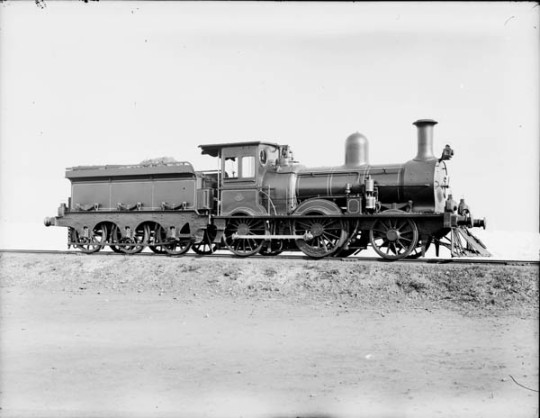
The railwaymen, flushed with success, had probably hoped to build the new 0-6-0s at Williamstown, however there were not sufficient facilities. Plans to the tune of £1,190 for a new boiler-shop were approved, with the likely idea of building more 2-4-0s, however there still wouldn't have been capacity for the six-coupled engines.
Wilson had, while in office, ordered six 0-6-0s from the Yorkshire Engine Co., which started to arrive in May 1871. Meikle was less than impressed - the 'Yorkies' were expensive (nearly three grand each) and shoddily built (you could talk them into coming apart.) Meikle wrote a disgruntled letter, with a laundry list of problems and concluding that no English company would accept machines such as this. The whole debacle gave the protectionists plenty of ammunition - when the Commissioner called tenders for ten more 0-6-0s to Meikle's new design, he gave only six weeks, keeping the English buildes out, and put on a 20 per cent import duty, to prevent builders in New South Wales weighing in.
Longmore, to the horror of the free-traders, also gave any fledgling Victorian builders a fortnight extension, and in answer to criticism cited Meikle's letter re. the 'Yorkies'. He also terminated the highly expensive English agent's contract, for allowing such dodgy work to be sent on.
The new 0-6-0 was neat but austere, with the object of competing with English builders on cost - Meikle did away with unnecessary brightwork - stove-pipe chimneys, plain splashers and painted dome covers, which prompted the nickname 'Greenbacks'.

There were a handful of very new foundries in Ballarat. The Victoria Foundry, the Phoenix Foundry, Victoria Ironworks, and Soho Works. Each had built a small number of 3'6" gauge locomotives for customers in Western Australia and New Zealand, mostly for use on timber tramways. All were quite eager for the job, and in the end, the contract for the 'Greenbacks' was awarded, tentatively, to a ready and willing Pheonix Foundry.

These new machines, the 'Q' class, might well have been the last new 5ft 3in gauge engines, with the govt. still reeling from the decision to make the new North Eastern line broad-gauge. Highinbotham and Longmore, the latter a strong narrow-gauge advocate, struggled over this issue for another year.
The new lines in the north-east were laid light, with 50lb iron rails, and the large, rigid English engines absolutely hammered them. The effect was nearly as disastrous as a break-of-gauge would have been - of the 102 engines rostered or ordered when the new light lines were confirmed, only a handful were light enough for the task. A locomotive of axle load 14 tons could do serious damage, crushing or laminating the rails, and splitting frail wooden sleepers.
There was also no way to prevent badly balanced locomotives being driven far too hard, and the light lines suffered badly. The Americans had solved this with their flexible 4-4-0s, and even the English had locomotives that could manage, but the protectionists wouldn't have it.
Worse still, on the steep light lines the small engines necessary to keep axle loading down would tend to have small driving wheels, and therefore would use a lot of steam to run even at low speeds, with the cylinders making more strokes in the same distance. They simply ran out of steam working at 'high' speeds (25mph) for too long. The large, heavy O class weighed 39 and a quarter tons, and could pull a 200-ton train up a 1-in-50 gradient. A Queensland Rlys. 'C', of 16 and a quarter tons, could only draw 65 tons up the same grade.

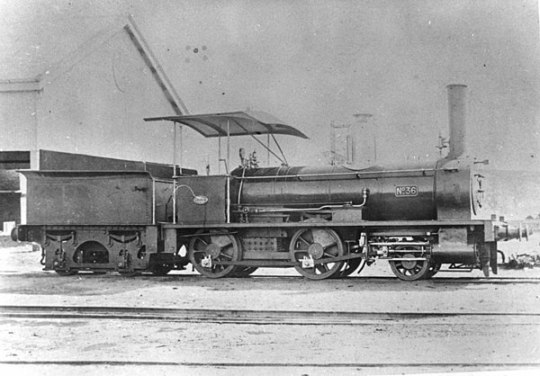
It was quite clear by mid-1872 that no local builder could supply all the engines required - the first 'Greenback' would not steam until March 1873, and with Longmore for the time being out of the way on the Opposition, Higinbotham and Meikle asked the new govt. to call tenders in England. This was done, with plans for six engines as a stop-gap measure, and two more light engines, one of a bogie design, which could be used as patterns and copied in the approved manner.
The protectionists were furious about this, and, lead by Major William Collard Smith MLA, or just 'The Major', raised hell in the Legislative Assembly that August. Not only was the Major the Mayor of Ballarat, he was also Chairman of the Pheonix Foundry Board... The idea of a conflict of interest apparently had not reached colonial Victoria just yet. At any rate, the Major, while prepared to accept the two 'pattern engines', he trusted that 'the Government will make an effort to withdraw the contract for the six engines.'
Somebody also raised the possibility of refurbishing the old G&MR engines, but the Minister of Railways tried to placate the protectionists by stating that he would call tenders in just a fortnight for nine more engines to be built locally, but Major Smith was not satisfied. The debate went on for some time. In the event for order for the six engines was cancelled, and with work on the telegraph cables somewhat more complete, this development reach Beyer Peacock in a timely manner.
The next day, 15th August, the Overseer of Locomotives' Office must have been in a state of disarray and panic. Design work for the nine engines may have been underway, but certainly not to a point at which it might tender for the contract with only two weeks' notice, not to mention specifications for the other six locomotives to be prepared. The two designs that came from this flurry of development were rather against Meikle's personal ideas, but are reflective of the state of being at the time.
Longmore had been assured by local ironworkers that local builders could build whole engines, sans wheels and complicated cranked-axles (ever the bane of locomotive builders.) To avoid them, the onus was on Meikle to put the cylinders outside. There were only two outside-cylindered engines on the roster at that point, G&M 'singles' No.34 and No.36, and Meikle therefore objected. He said that 'if you want a perfect engine, you must have inside cylinders.'

The implication of outside cylinders is that, on a small six-wheeled engine, the short connecting rods would create great lateral oscillation, but with the situation desperate, and no-one in the colony being able to make cranked axles, they were a rigid design requirement. For the sake of avoiding importing this single piece, the protectionists almost ended the light lines before they had begun.
25 notes
·
View notes
Text

This is Stephen in his animal form! He's a traditionally depicted unicorn. He has a curved horn unlike the other train-unicorns. Also, the barrel that the real Stephenson's Rocket has is his dressage.
In my au he looked like this for a long time until he got a rebuild in King of the Railway.
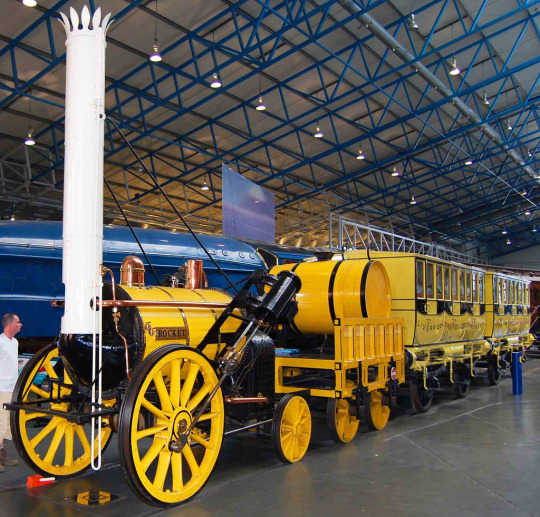

#thomas and friends#ttte#sketch#ttte stephen#unicorn#traditional unicorn#king of the railway#ttte au
7 notes
·
View notes
Video
Chicago Aurora & Elgin 36 (1902 Stephenson) with 319 (1914 Jewett) interurban cars at the Illinois Railway Museum. 9/23 por Bryan Burton
12 notes
·
View notes
Text










Colinton Tunnel.
The mural in the tunnel follows a theme taken from the poem ‘From A Railway Carriage’, originally published in Robert Louis Stephenson book ‘A Child’s Garden Of Verses’
Robert would have ridden the Colinton Railway as a child and the poem is said to have been inspired by the journey. His Grandfather was the vicar at the local Manse.
As a child and also into adulthood Robert was unwell with a chronic lung disease, during times when he was suffering he mainly concentrated on children’s verse being too unwell to focus on his long format writing.
Faster than fairies, faster than witches,
Bridges and houses, hedges and ditches;
And charging along like troops in a battle,
All through the meadows the horses and cattle:
All of the sights of the hill and the plain
Fly as thick as driving rain;
And ever again, in the wink of an eye,
Painted stations whistle by.
Here is a child who clambers and scrambles,
All by himself and gathering brambles;
Here is a tramp who stands and gazes;
And there is the green for stringing the daisies!
Here is a cart run away in the road
Lumping along with man and load;
And here is a mill and there is a river:
Each a glimpse and gone for ever!
#scotland#scottish#Edinburgh#former railway tunnel#colinton#robert louis stevenson#poet#poem#mural#public art#history#my pics
48 notes
·
View notes
Text
13.7 Billion Years in the Making RAILWAY SERIES MASTER POST!
Humanoid drivers are extension Engines on the island of Sodor! strange visitors came to the island and cause havoc and confusion for Sudrians and it's up to our tank engines to solve the mystery of those who are missing.
this WebComic series is rated TV-14: intensive violence, language, suggestive content, usage of alcohol, and adult themes

Reference sheets
Steam Team 1-6
Thomas
Green Thomas
Henry
James
The Diesels
Diesel
Dawn
Bryan
Proteus, Godred, Stephenson, Scotsmen
Rolling stocks
Other characters
Cranky
Ten Cents
QnA
How do they become Humanoids?
Mask lore
What happens if you take it off
Fun facts about humanoids
Their heights
Engine X-ray
Hair lore
Diesel blood
Truck lore 2
Diesel 10
Out of service
Prologue
Twos Diesels
Act 1
Where's duck? + I am duck!
Looking for some body + where's my brother
Over Heating
Oliver's Exploit
Sunny the Magic Baby
Hello me from another dimension
Fixing arms
Inconvenience
Act 2
I.Human
Who's the new guy?
Lockdown due to complications
New tasks and orders+ new shed
Duck's day off
Duck season
Breaking into Diesel 10s shed
Full bodied claw
A walking corpse
Act 3
Man to engines
#thomas the train#ttte humanized#ttte fanart#ttte au#ttte#ttte human au#ttte humanisation#crossover fraternity#webcomic#masterpost#13.7BYITM
85 notes
·
View notes
Text
“I wish... it never had happened… I am truly sorry...”
“It was never your fault, Rocket.”


Stephenson’s Rocket
The locomotive involved in the first widely reported passenger train death.
On September 15, 1830, during the opening ceremony of the Liverpool and Manchester Railway, William Huskisson, a British statesman, while greeting the Duke of Wellington when his train was stopped for water, lost his balance and fell onto the path of Stephenson’s Rocket, which ran over Huskisson’s leg.
Huskisson was driven to a hospital by George Stephenson himself, but due to the severity of the injury, he died later that day, he was 60 years old.
Under every golden crown, is a burdened heart.
33 notes
·
View notes
Photo

Dampflokomotive ADLER (Nachbau). Die erste Lokomotive, die kommerziell im Personen- und später auch Güterverkehr in Deutschland fuhr. Heute beim Sommerfest des DB Museums in Koblenz.
Steam locomotive ADLER (replica). The first locomotive to run commercially in passenger and later also freight traffic in Germany. Today at the DB Museum summer festival in Koblenz.
#dampflokblog.de#ADLER#dampflok#DB Museum Koblenz#stoom locomotief#locomotora a vapor#locomotive à vapeur#stoomtrein#Steam train#locomotora#lokomotywa#locomotive#fireless locomotive#Railway#Eisenbahnmuseen & Betriebshöfe#Dampfwagen#robert stephenson and company#Stephenson#鉄道#локомотив#узкоколейный локомотив#lokomotywa wąskotorowa
23 notes
·
View notes
Text
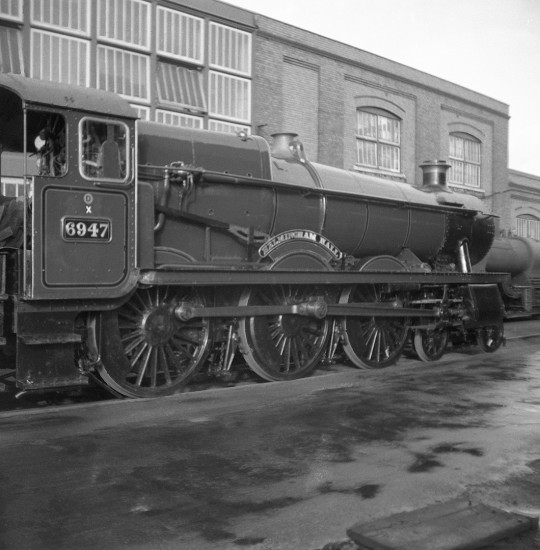

Ex-GWR ‘Hall’ Class 4-6-0 No 6947 ‘Helmingham Hall’ in ex-works condition outside its birthplace, Swindon Works, 24 November 1963. Built at Swindon Works in 1942 this loco was withdrawn from Oxford shed in November 1965 and scrapped.
Photo credits: Julian Holland
BRITAIN’S STEAM LOCOMOTIVES
From Penydarren to Tornado
It is now over 200 years since the world’s first steam railway locomotive made its maiden voyage along a primitive plateway in South Wales – in 1804 Richard Trevithick’s high-pressure steam locomotive successfully hauled a loaded train a distance of nine miles at an average speed of just over two mph. Only 25 years later Robert Stephenson’s Rocket won the Rainhill Trials in Lancashire with a top speed of nearly 30 mph. With Britain leading the way the evolution of the steam locomotive continued unabated through the 19th and into the 20th centuries, culminating in Nigel Gresley’s streamlined Mallard which still holds the world record for steam railway locomotives of 126 mph that was set in 1938.
Although steam haulage on Britain’s nationalized railways ended in 1968, the British public’s love affair with these living mechanical monsters continues unabated – steam haulage on the country’s national rail network and heritage railways is now a regular feature with packed trains being hauled by lovingly restored locomotives that were saved from the scrapheap some decades ago. Britain’s love affair with steam is set to continue.
Written by bestselling railway author Julian Holland, Britain’s Steam Locomotives is a fitting memorial to over two centuries of British steam locomotive design.
6 notes
·
View notes
Text
History likes fucking with people sometimes. There are two (2) very famous Engineers called Robert Stephenson/Robert Stevenson. One lived between 1772 - 1850, was born and died in Scotland and was known for lighthouses. The other one, lived 1803 - 1859 and (along with his Father George) is known as "Father of the Railways" and revolutionised railways and the only difference in their names is one is spelt with a v and the other with a ph. Their lives overlap, they're both FAMOUS engineers, and the only difference between them is one is known for railways and spells his name with a ph, and the other one is known for lighthouses and is spelt with a v.
5 notes
·
View notes
Text
Victoria Railways No.36, originally Geelong & Melbourne 'Oberon'. Stephenson 1007/1856. 2-4-0WT.

14 notes
·
View notes
